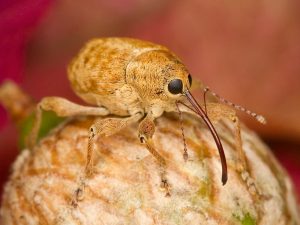Not every acorn is destined to become an oak tree, with most ending up as food for a variety of creatures, big and small. Squirrels of course eat many of them, along with deer, turkey, and other birds. But the abundance of acorns in most years also feeds much smaller creatures that also depend upon this bountiful resource. Although we may not ever see them, we know that they are around because of the holes that they leave behind – perfectly round holes seen in acorns in the fall.

As for the term weevil, it refers to the long, curved snouts that provide the means by which these insects feed, mostly on plant matter, including grains, nuts, and fruit. These “cute” little insects are part of one of the most diverse groups of organisms in the world – the beetles, that are estimated to include from 800 to 900,000 species worldwide.
The weevils in our acorns are part of the family Curculionidae, known as “true” weevils or “snout beetles” and is one of the largest animal families in our world, with about 83,000 species. And that only includes the species that have been described. Estimates as to the undescribed species range as high as double that number! This incredible diversity within a group of organisms has long been noticed by scientists, dating to the 19th century when one of the prominent biologists of the time was asked about what he thought the Creator had in mind relative to this group of organisms. His answer was “An inordinate fondness for beetles”.
There are a number of species of acorn weevils found across the U.S., including “long-snouted” and “short-snouted” forms. And yet, acorn weevils are not the only insects to feed upon the mast of our forest trees, prominent among these being the acorn moths – but that is a different “hole” and for another time 😊.
Hope to see you in our great outdoors!!!